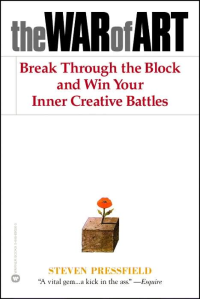Book Title: The War of Art – Break Through the Block and Win Your Inner Creative Battles
Steven Pressfield and his work, the War of Art has been a recurring reference across many of my readings in recent times. I gave myself enough reasons to delay its purchase. Something in me kept resisting to pick this book up. So here I am eventually writing a note of me overcoming the resistance to read this book which incidentally is on resistance.
Every individual who engages in any form of art recognizes the importance of acknowledging and overcoming resistance. Many times we don’t even recognize that the force which is not allowing us to create is sitting right within us. Pressfield’s book aptly titled the War of Art bears it all. Inside every artist (veterans included) this battle ensues daily. This battle is actually between the life we are living and the unlived life within us. The first part of the book clearly defines this enemy called resistance in every form possible. As we go through the various definitions of resistance and its manifestations, one is bound to acknowledge experiencing its presence. If we have any doubts after this, a section titled symptoms of resistance quickly makes us sure of it presence.
Resistance is universal. It cannot be done away with. But it can be beaten. It requires a conscious move from being an amateur to becoming a professional. The way Pressfield defines who a professional is seems interesting and demanding. As we move through the book beyond this point, the text slowly but surely leads to some fundamental truths about life and giving. These pages are an extract of the wisdom of the world’s greatest teachers. There are references to Indian scriptures as well as western ones. The importance of owning the right to action and not the results thereof is beautifully captured from a variety of perspectives. There are references to scriptures of the east and west as well as poems and movies that showcase these truths. The author also attempts to differentiate between the ego (philosophically, the little self) and the self. These require not just plain reading but extensive reflection. The author’s detailing of the importance for an artist to find their territory and his description of what a territory means is simply fascinating. Some of the questions in this section are simple and straight, difficult to handle for people without courage. One of the last sentences I made note of before completing the book was this, “Don’t cheat us of your contribution, give us what you’ve got”. Isn’t that a clarion call to live the life we are meant to live?
I read the e-book version and kept wondering how such an interesting book albeit a small one would have been made in print. Sometime in the future when I decide to reread this book, I may prefer to pick a hard copy. While it should be compulsory reading for all who consider themselves artists, it definitely makes good reading for everyone.
NOTE: 14th to 20th November is celebrated annually in India as the ‘National Book Week’. As part of the celebration I am posting ‘book reviews’ daily. Happy Reading!

